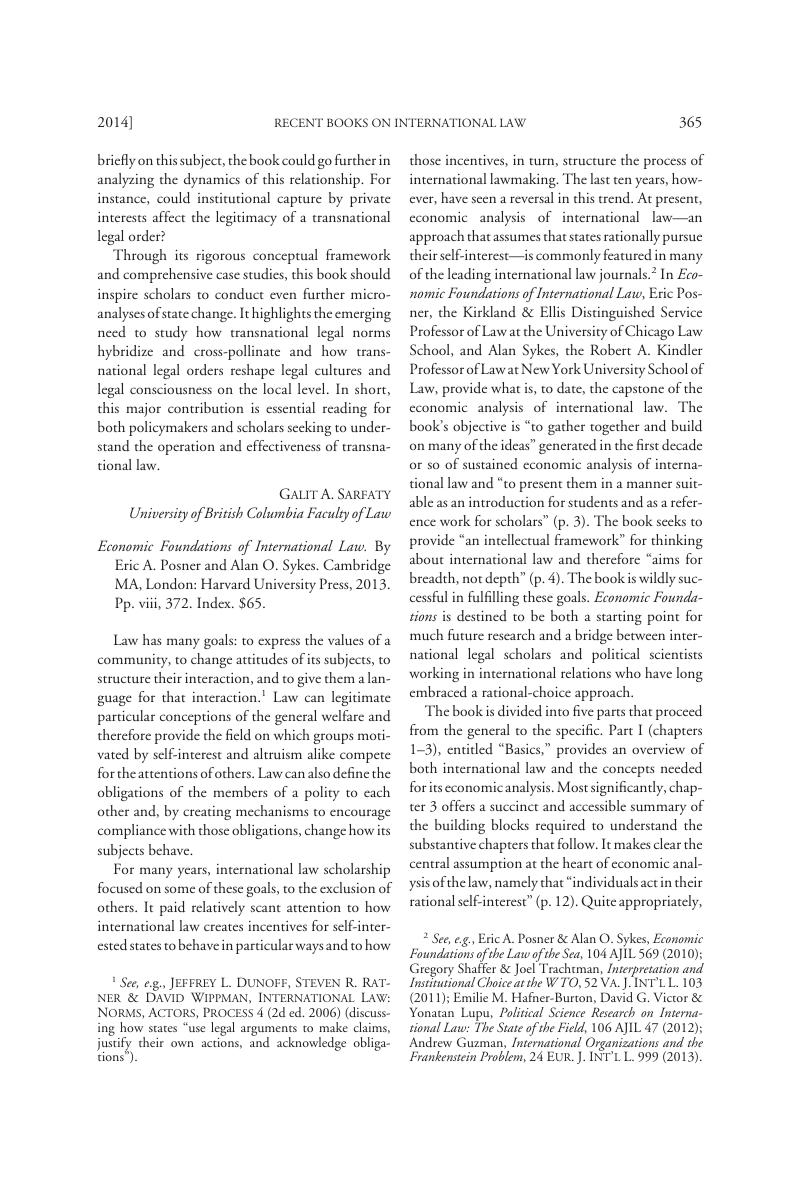No CrossRef data available.
Published online by Cambridge University Press: 20 January 2017

1 See, e.g., Jeffrey L. Dunoff, Steven R. Ratner & David Wippman, International Law: Norms, Actors, Process 4 (2d ed. 2006) (discussing how states “use legal arguments to make claims, justify their own actions, and acknowledge obligations”).
2 See, e.g., Posner, Eric A. & Sykes, Alan O., Economic Foundations of the Law of the Sea, 104 AJIL 569 (2010)CrossRefGoogle Scholar; Shaffer, Gregory & Trachtman, Joel, Interpretation and Institutional Choice at the WTO, 52 Va. J. Int’l L. 103 (2011)Google Scholar; Hafner-Burton, Emilie M., Victor, David G. & Lupu, Yonatan, Political Science Research on International Law: The State of the Field, 106 AJIL 47 (2012)CrossRefGoogle Scholar; Guzman, Andrew, International Organizations and the Frankenstein Problem, 24 Eur. J. Int’l L. 999 (2013)CrossRefGoogle Scholar.
3 See Michael Wood (Special Rapporteur), Formation and Evidence of Customary International Law, UN Doc. A/CN.4/653 (May 30, 2012); Murphy, Sean D., Immunity Ratione Personae of Foreign Government Officials and Other Topics: The Sixty-Fifth Session of the International Law Commission , 108 AJIL 41, 52–53 (2014)Google Scholar.
4 Vienna Convention on the Law of Treaties, Art. 31(3)(b), May 23, 1969, 1155 UNTS 331 (stating that a treaty interpreter shall examine “any subsequent practice in the application of the treaty which establishes the agreement of the parties regarding its interpretation”) [hereinafter Vienna Convention]; Monica Hakimi, Law and the Universal Human Rights Treaties, Duke Geneva Conference on the Role of Opinio Juris in Customary International Law (2013) (unpublished manuscript) (on file with author) (arguing that the Vienna Convention’s state practice requirement for treaty interpretation is similar to customary international law’s state practice requirement).
5 See, e.g., Draft Articles on Responsibility of States for Internationally Wrongful Acts, in Report of the International Law Commission on the Work of Its Fifty-Third Session 43, UN GAOR, 56th Sess., Supp. No. 10, UN Doc. A/56/10 (2001).
6 See, e.g., Charney, Jonathan I., Universal International Law, 87 AJIL 529, 543–48 (1993)CrossRefGoogle Scholar.
7 See, e.g., Dunoff, Jeffrey L. & Trachtman, Joel P., Economic Analysis of International Law, 24 Yale J. Int’l L. 1, 36 (1999)Google Scholar (discussing the theory of the firm’s applicability to international organizations); Meyer, Timothy, Epistemic Institutions and Epistemic Cooperation in International Environmental Governance, 2 Transnat’l Envtl. L. 15, 28 (2013)CrossRefGoogle Scholar (applying the concept of asset specificity to explain whether technical and expert bodies should be integrated into, or independent of, international law making bodies).
8 In addition to the Security Council and the European Union, treaties such as the Montreal Protocol permit some binding technical changes to be made by a vote of the parties. Montreal Protocol on Substances That Deplete the Ozone Layer, Art. 2.9, Sept. 16, 1987, S. Treaty Doc. No. 100-10 (1987), 1522 UNTS 3, 26 ILM 1550 (1987) [hereinafter Montreal Protocol]; see Helfer, Laurence R., Nonconsensual International Lawmaking, 2008 U. Ill. L. Rev. 71 Google Scholar (discussing examples of nonunanimous lawmaking).
9 Meyer, Timothy, From Contract to Legislation: The Logic of Modern International Lawmaking, 14 Chi. J. Int’l L. 559, 569–70 (2014)Google Scholar.
10 U.S. Const. Art. I, §10.
11 Vienna Convention, supra note 4, Art. 9.
12 Schaack, Beth Van, Negotiating at the Interface of Power and Law: The Crime of Aggression, 49 Colum. J. Transnat’l L. 505, 518–21 (2011)Google Scholar.
13 Cf. Joel P. Trachtman, The Future of International Law: Global Government 253 (2013) (“There will be increased demand both for more international law and for more international organizational capacity to provide mechanisms for legislative or decision-making action.”); Guzman, Andrew T., Against Consent, 52 Va. J. Int’l L. 747, 763 (2012)Google Scholar (“An excessive commitment to consent can cripple efforts to use international law as a tool to help solve the world’s largest problems.”); see also Palmer, Geoffrey, New Ways to Make International Environmental Law, 86 AJIL 259, 279 (1992)CrossRefGoogle Scholar (describing an international legislature for environmental law capable of binding states).
14 See Meyer, supra note 9, at 564; Weingast, Barry R. & Marshall, William J., The Industrial Organization of Congress; or, Why Legislatures, Like Firms, Are Not Organized as Markets, 96 J. Pol. Econ. 132 (1988)CrossRefGoogle Scholar.
15 Nor can cooperation-minded states costlessly step outside of a COP to enter into the same agreement among themselves. Modern international institutions are usually continuing bodies that develop law over time. If a subsequent instrument is not made by the legislative body governing the institution, it may not be related to the governing instrument and therefore may lose much of its value. For example, if a trade agreement is adopted outside of the WTO, the WTO’s already well-developed dispute settlement process will not be available to resolve disputes under that agreement. Similarly, if the crime of aggression had been defined by a treaty only among states favoring a strong definition of aggression (and therefore outside of the Assembly of the Parties to the ICC), the ICC would not have been able to prosecute the crime as defined. In the environmental context, decisions by COPs, such as the COP to the Stockholm Convention, to subject certain chemicals to the Convention’s controls reduce transaction costs by relating a very narrow decision—the control of a particular chemical—to an already existing legal framework.
16 Meyer, supra note 9, at 591.
17 at http://www.ustr.gov/tpp.
18 See Elms, Deborah, Getting the Trans-Pacific Partnership over the Finish Line, NBR Analysis Brief (Oct. 22, 2012)Google Scholar, available at http://www.nbr.org/publications/nbranalysis/pdf/brief/102212_Elms_TPP.pdf.
19 See Meyer, supra note 9, at 594.
20 Montreal Protocol, supra note 8.
21 15 U.S.C. §78dd-1 et seq.
22 See Montreal Protocol, supra note 8, Art. 4(requiring parties to the Montreal Protocol to impose trade sanctions on nonparties not in substantive compliance with the treaty’s terms).
23 See, e.g., Scott Barrett, Environment and Statecraft: The Strategy of Environmental Treaty-making (2003).